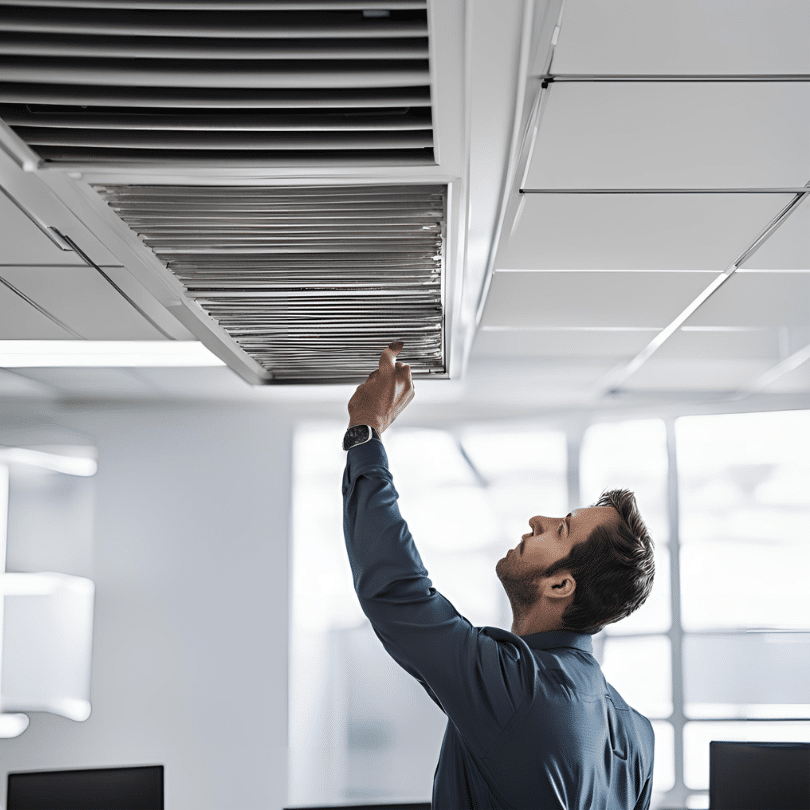Indoor Air Quality Management for Building and Facilities Managers

Poor indoor air quality can harm the health and well-being of building occupants. It can be caused by various factors, from the off-gassing of volatile organic compounds (VOCs) and chemicals from building materials to mold growth and air pollution. As a building or facility manager, you can directly impact the indoor air quality in your building to facilitate a safe and healthy environment for occupants. This article will provide guidance on how to prevent and manage indoor air quality issues in commercial properties and help building managers comply with regulations.
What is Indoor Air Quality, and Why is it Important?
Indoor air quality is not just a matter of comfort–it’s a matter of health. Poor indoor air quality can lead to various health problems, from allergies and respiratory issues to more serious conditions like lung cancer. It can also cause headaches, fatigue, and reduced productivity among building occupants, leading to business disruption. These potential health risks underscore the importance of a proactive approach to indoor air quality management, making it a top priority for building and facility managers.
Common Indoor Air Quality Issues
Indoor air quality issues commonly found in commercial properties include:
- Mold and bacteria growth due to moisture build-up
- Volatile organic compounds (VOCs) and chemicals from building materials, cleaning products, and furnishings
- Poor ventilation and air filtration systems
- Air pollution from outdoor sources such as traffic and construction
Identifying the root cause of any indoor air quality issues is important for effectively managing them.
Identifying Common Indoor Air Pollutants
Dust, mold, asbestos, and volatile organic compounds (VOCs) are among the most prevalent indoor air pollutants encountered in commercial buildings. While these pollutants can originate from various sources, both within and outside the building, their impact on indoor air quality can be significant and pose risks to the health and well-being of occupants.
Dust Accumulation
Dust particles are ubiquitous in indoor environments and can originate from various sources, including outdoor air infiltration, human activities, and building materials. While some dust is unavoidable, excessive accumulation can lead to poor indoor air quality and exacerbate respiratory issues, such as allergies and asthma. Common dust sources in commercial buildings include carpeting, upholstered furniture, and ventilation systems.
Mold Growth
Mold growth is common in buildings with moisture issues, such as leaks or high humidity levels. Mold spores can proliferate in damp environments and release allergens and irritants into the air, potentially causing respiratory problems and other health issues. Areas prone to mold growth in commercial buildings include basements, bathrooms, and areas with poor ventilation.
Asbestos-Containing Materials
Although asbestos use has declined significantly in recent decades, it may still be present in older buildings, particularly those constructed before the 1980s. When disturbed, asbestos-containing materials such as insulation, ceiling tiles, and flooring can release hazardous fibers into the air, posing a serious health risk to occupants. Proper identification and management of asbestos-containing materials are essential to prevent exposure and maintain indoor air quality.
Exposure to Volatile Organic Compounds
VOCs are a diverse group of chemicals that can off-gas from various building materials, furnishings, and cleaning products. Common sources of VOCs in commercial buildings include paints, adhesives, sealants, carpets, and office equipment. Prolonged exposure to high levels of VOCs can lead to a range of health effects, including headaches, nausea, respiratory irritation, and exacerbation of existing conditions such as asthma. Minimizing VOC emissions through proper ventilation and using low-emission products is essential for maintaining healthy indoor air quality.
Recognizing the Symptoms of Poor Indoor Air Quality
Poor indoor air quality can manifest in various symptoms among building occupants, ranging from mild discomfort to more severe health issues. Common symptoms include headaches, dizziness, fatigue, respiratory irritation, eye and throat irritation, and exacerbation of allergies or asthma. However, because these symptoms can overlap with other health conditions or be subtle, they are often overlooked or attributed to other causes. Therefore, it’s crucial for property owners and managers to be vigilant and responsive to reports of discomfort or illness among building occupants and to conduct thorough investigations to identify potential indoor air quality issues.
The Role of Building Management
Building managers are pivotal in the effective management of indoor air quality. Their proactive and multifaceted approach is key to identifying and addressing potential issues, implementing preventive measures, and ensuring compliance with regulatory requirements. By conducting regular inspections, monitoring indoor air quality parameters, and promptly addressing any identified concerns, building managers can significantly improve the indoor environment for occupants. Moreover, fostering open communication with building occupants and providing education and resources on indoor air quality issues commonly found in commercial properties include:
- Mold and bacteria growth due to moisture build-up
- Volatile organic compounds (VOCs) and chemicals from building materials, cleaning products, and furnishings
- Poor ventilation and air filtration systems
- Air pollution from outdoor sources such as traffic and construction
Identifying the root cause of any indoor air quality issues is important to manage them effectively.
In summary, understanding the typical indoor air quality issues encountered in commercial buildings, recognizing the associated symptoms, and implementing proactive management strategies are essential for maintaining a healthy indoor environment for occupants. By addressing indoor air quality concerns promptly and effectively, property owners and managers can create spaces that promote occupant health, well-being, and productivity.
Preventing Indoor Air Quality Issues
- Building and facility managers can take several steps to prevent indoor air quality issues, such as:
- Regularly inspecting HVAC and air filtration systems and replacing filters as needed
- Ensuring proper ventilation in all areas of the building, including restrooms and kitchens
- Choosing low-VOC building materials and cleaning products
- Cleaning up any water spills or leaks immediately to prevent mold growth
- Implementing regular cleaning and maintenance schedules
Prevention is the cornerstone of maintaining healthy indoor air quality. Building managers should prioritize ongoing maintenance and monitoring to prevent issues from arising. By taking proactive steps, such as regular inspections, ensuring proper ventilation, and choosing low-VOC materials, they can significantly reduce the risk of indoor air quality issues and create a healthier environment for occupants.
Managing Indoor Air Quality Issues
If indoor air quality issues arise, building managers should immediately address the root cause and mitigate any health risks for building occupants. This may include:
- Conducting an indoor air quality assessment to identify the source of the problem
- Removing or addressing the source of the issue, such as mold growth or chemical off-gassing
- Implementing engineering controls, such as improving ventilation or air filtration systems
- Educating building occupants on how to maintain healthy indoor air quality
Building managers have a responsibility to comply with relevant regulations, such as OSHA requirements and state laws regarding indoor air quality. This not only protects the health and safety of building occupants but also demonstrates a commitment to ethical and legal practices. Working with a qualified environmental consulting firm can provide the expertise and support needed to manage indoor air quality issues effectively, further reinforcing this commitment.
Partner with an Environmental Expert to Assess Indoor Air Quality
Indoor air quality is subject to regulation under OSHA requirements and California law. The California Division of Occupational Safety and Health establishes policies for investigating reports of poor indoor air quality in the workplace, which can lead to citations and penalties. The state’s Air Resources Board and Air Quality Management Districts collect millions of dollars in penalties yearly and can refer cases for criminal prosecution.
An indoor air quality assessment can help you stay in compliance and avoid the expense and disruption of regulatory issues.
At Omega Environmental, our experts have deep experience in the assessment and mitigation of indoor air quality issues and can help you quickly determine the source and severity of any problems and create a remediation plan. We provide inspection and laboratory analysis to establish whether you are dealing with a serious problem or simply the remains of someone’s leftover lunch in the office fridge. Our services include a wide range of offerings for the management and prevention of indoor air quality issues, such as:
- Sick building syndrome evaluations
- Microbial sampling and analysis
- Water damage and moisture evaluations
- Mold remediation project design and oversight
- Proactive Indoor Environmental Quality (IEQ) management plans
- Customized IEQ training programs
Our team includes some of the country’s leading experts in environmental assessment, consulting, remediation, and industrial hygiene. We partner with government and private contractors, engineers, architects, construction managers, and building managers across California to facilitate safe and cost-effective environmental strategies for health, safety, and compliance.
Call Omega today and tell us about your building’s indoor air quality. We are experts in indoor air quality assessments for commercial buildings and facilities.
FAQ – Indoor Air Quality Management for Building and Facilities Managers
Q: What are some specific examples of low-VOC building materials and cleaning products that can be used to minimize indoor air pollution?
A: Low-VOC building materials and cleaning products are essential for minimizing indoor air pollution in commercial properties. Examples of low-VOC building materials include paints labeled as “low-VOC” or “zero-VOC,” which emit fewer harmful chemicals into the air during application and drying. Similarly, selecting adhesives, sealants, and flooring products with low VOC content can help reduce indoor air pollution. Look for certified green cleaning products prioritizing indoor air quality and occupant health.
Q: How can building managers effectively educate and communicate with building occupants about the importance of indoor air quality and best practices for maintaining healthy environments?
A: Effective communication and education are key components of indoor air quality management in commercial buildings. Building managers can implement various strategies to educate and engage building occupants in IAQ initiatives. This may include hosting workshops or seminars on indoor air quality, distributing informational materials such as brochures or newsletters, and incorporating IAQ awareness into employee training programs. Additionally, establishing open lines of communication between building management and occupants, such as through email newsletters or digital signage, allows for ongoing dialogue and feedback regarding IAQ concerns and best practices.
Q: Are there any emerging technologies or innovations in indoor air quality management that building managers should be aware of, and how can they be implemented in commercial properties?
A: Emerging technologies and innovations in indoor air quality management offer promising solutions for building managers looking to enhance IAQ in commercial properties. Additionally, IoT (Internet of Things) sensors and monitoring devices provide real-time data on indoor air quality parameters, allowing building managers to identify trends, track changes, and implement targeted interventions as needed. By staying informed about the latest developments in IAQ technology and incorporating innovative solutions into management strategies, building managers can stay ahead of the curve and create healthier indoor environments for occupants.










